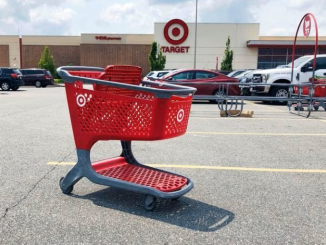
Deemed a “Dystopian Apartment,” a building in China has recently gone viral on TikTok. Incredibly, it has the ability to host up to 30,000 residents.
The video was posted by @fatheristheone using a drone and caught people’s attention for more than just the impressive interior and unique design.
People were also astonished after seeing footage that truly captivates the enormity of the building.
Many people have read at least one novel focusing on a Dystopian society. Or at least understand that it describes a society that lives in fear or has been dehumanized.
Most works have been fiction, although some might argue they’re a possible warning about the future.
Either way, China currently has an apartment building that can house up to 30,000 residents at one time. Furthermore, containing everything residents could possibly need.
Features of the Dystopian Apartment
The “dystopian” apartment, called the Regent International, is located in Qianjiang Century City, more specifically, in Hangzhou’s central business district.
The building was actually designed by Alicia Loo, chief designer of a 7-star hotel called the Singapore Sands Hotel, and was inaugurated in 2013.
Impressively, the building is 675 feet tall and is currently home to around 20,000 residents. It is an S-shape and has 36, or 39, floors depending upon which side of the building you are.
Unsurprisingly, it’s one of the most densely populated areas in the world, thanks to the numerous residents coexisting under one giant roof.
Within the more than 30 floors of the Regent International, there are a number of amenities. Some include restaurants, swimming pools, and nail salons.
The building also contains its own grocery stores and internet cafes. Essentially, anything one might find “in town” can be found indoors the “dystopian apartment”.
As a result, many residents may never step foot outside again. Posing the question, will they also never get any fresh air or feel the sunlight on their skin? First, the residents aren’t forced to stay indoors, nor are they forced to live in the “dystopian apartment.”
In contrast, most residents are young professionals and influencers or college students. Both of them greatly benefit from the cost-effectiveness and convenience of living in a place such as an S-shaped building.
Advantageous Living
Living there seems to be incredibly convenient for residents as they have everything they could possibly need under one roof.
Convenience isn’t the only advantage. Its affordability is another great benefit to living at Regent International.
Units vary in size and cost but range from 1,500 RMB, which is equivalent to around $200.00 per month, to 4,000 RMB, which is just under $600.00 per month.
While some are apprehensive, calling it a “dystopian apartment,” others have praised the innovation behind the building. It’s even been called “the most sustainable living building on earth.”
Another interesting advantage comes to light in the midst of a housing crisis that is seemingly sweeping the U.S. The “dystopian apartment” could serve as a model for how the U.S. can possibly create more living spaces for people without taking up copious amounts of land.
Interestingly, one state has already developed something like the hotel turned apartment city. Whittier, a city in Alaska, has a 14-floor building in which all 272 residents live. It, like the building in China, has everything one would find “in town.” This includes a church, school, post office, and police station.
Possible Downsides
Like everything in life, this, too, has pros and cons. After all, the building has been referred to as “dystopian apartment” for a reason.
As previously mentioned, many people are wondering how so many people can live in one place. U.S. residents tend to prefer privacy. Space from their neighbors. Even a yard to hang out in or for their dogs to play.
A major drawback to a housing solution like this is that people will have very little space of their own, with little opportunity to be outdoors or get fresh air. Luckily, the problem of getting fresh air can be remedied by taking a stroll or renting one of the larger units in the Regent International, as some come with balconies, providing some relief from living in there.
McDonald’s has turned its golden arches upside down to make an interesting statement.

McDonald’s, one of the largest fast-food restaurants in the globe, celebrated women and reminded them that they are all great in their own special ways by inverting its famous arches.
The company made the decision to flip Mickey’s arches on March 8, 2018, International Women’s Day, a “global day celebrating the social, economic, cultural, and political achievements of women.”
Many were so shocked by the transformation and thought they had visited a foreign planet that they conjectured it had anything to do with the company’s ongoing conflict with Wendy’s.
But they were completely wrong. Instead, the emblem has been flipped as part of a “celebration of women everywhere,” according to a spokeswoman.McDonald’s decided to update the signage of their Lynwood, California location while keeping their social media logos the same.
The “W”-shaped symbol was worn by employees on shirts and caps at the same time, and 100 restaurants countrywide provided special packaging with the logo.”For the first time in our brand’s history, we flipped our iconic arches for International Women’s Day to celebrate the amazing accomplishments of women everywhere, especially in our restaurants.” Wendy Lewis, Chief Diversity Officer at McDonald’s, stated.
A brand spokesperson, Lauren Altman, claims that the new design was created to honor women everywhere. “We have a long history of empowering women to advance and prosper in the workplace.”
We are pleased to announce that six out of ten restaurant managers in the US are now women. We’re proud of our variety,” she continued. The corporation will update its logo on all social media channels, and 100 websites will receive new “packaging, crew shirts, hats, and bag stuffers.”

McDonald’s isn’t the only company that supports gender equality and rewards women.In the past, Johnnie Walker released a “Jane Walker” bottle in honor of women, with $1 from the sale of each bottle going to organizations that promote women’s rights.”In society, gender conversations are still very important.”
And we believe that this is the perfect time to launch our Jane Walker logo and support progressive groups that share our values,” vice president Stephanie Jacoby of Johnnie Walker said.
“We are proud to honor the numerous accomplishments of women as well as everyone’s progress toward gender equality.”
One of the companies supporting the initiative was Brawny, which replaced the Brawny Man with a woman and donated $100,000 to Girls, Inc.
What thoughts do you have about this?Please TAG your friends and family with this story on Facebook.



Leave a Reply